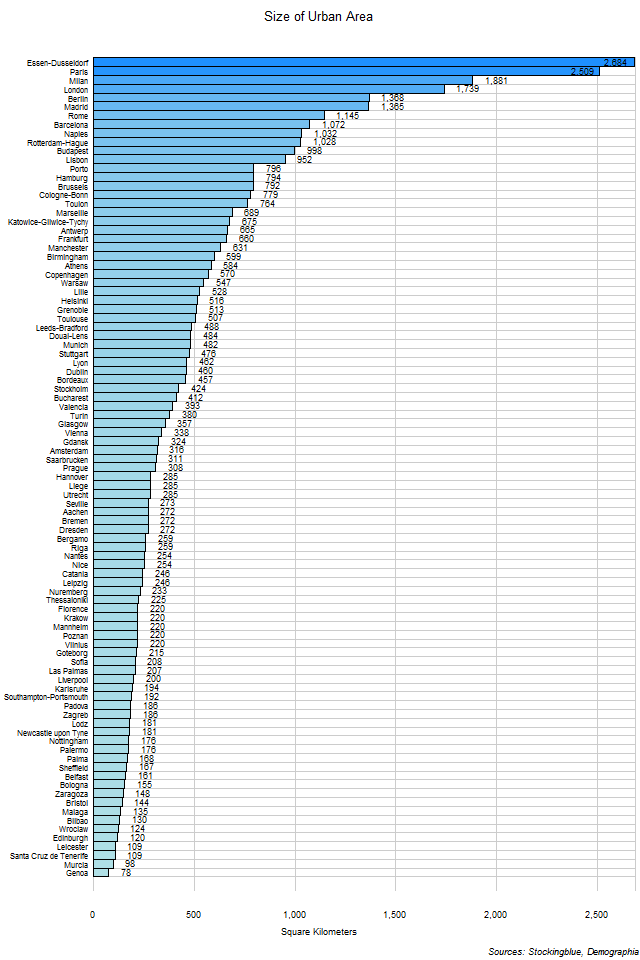
The chart above shows the urban area of each city with a population of over one million. The urban area has been normalized so as to avoid any inconsistencies with how cities and their metropolitan areas are defined by their governments. Each urban area has similar characteristics making this the definitive method with which to compare cities across various countries. Essen-Dusseldorf is the largest urban area in the EU followed closely behind by Paris.
Findings
- The difference between the urban area with the greatest size, Essen-Dusseldorf, and the urban area with the least, Genoa, is 2,606 square kilometers.
- Essen-Dusseldorf has 34.41 times the urban area that Genoa does.
- The median size of urban area with a minimum population of one million in the 28 EU states is 308 square kilometers and the mean 488.41 square kilometers.
Caveats
- Data is from 2020.
- The methodology for how these urban areas have been defined can be found in the source link below. As of this writing this is the most reliable way to compare urban areas throughout the world.
- All figures are rounded to the nearest whole.
Details
Only 22 of the 28 EU states have urban areas with at least one million people. Of these, Germany has 16; the United Kingdom has 14; France, Italy, and Spain each have 11; Poland has seven; Belgium and the Netherlands each have three; Greece, Portugal, and Sweden each have two; and Austria, Bulgaria, Croatia, Czechia, Denmark, Finland, Hungary, Ireland, Latvia, Lithuania, and Romania each have one.
Essen-Dusseldorf makes up one-twentieth of the total area of EU urban areas with over one million inhabitants at 5.90%. It, along with Paris, Milan, London, and Berlin make up one-fifth of the total area of EU urban areas with over one million inhabitants at 22.41%. Adding in Madrid brings it up to over one-quarter at 25.42%.
Ten urban areas with a population of over one million people have an urban area of over 1,000 square kilometers. Two have an urban area of less than 100 square kilometers.
Germany has the largest area covered by its urban areas of over one million people with a total of 9,548 square kilometers distributed among its 16 urban areas. France follows with 7,421 square kilometers among its 11 urban areas. They are followed by Italy (5,758 square kilometers), the United Kingdom (5,264 square kilometers), Spain (4,098 square kilometers), Poland (2,291 square kilometers), Portugal (1,748 square kilometers), Belgium (1,742 square kilometers), the Netherlands (1,629 square kilometers), Hungary (998 square kilometers), Greece (809 square kilometers), Sweden (639 square kilometers), Denmark (570 square kilometers), Finland (516 square kilometers), Ireland (460 square kilometers), Romania (412 square kilometers), Austria (338 square kilometers), Czechia (308 square kilometers), Latvia (259 square kilometers), Lithuania (220 square kilometers), Bulgaria (208 square kilometers), and Croatia (186 square kilometers).
Cyprus, Estonia, Luxembourg, Malta, Slovakia, and Slovenia do not have any urban areas with a population of over one million inhabitants.
Data
| State | Total Area (in square kilometers) | Average Area | Median Area | Number of Large Urban Areas |
|---|---|---|---|---|
| Austria | 338 | 338 | 338 | 1 |
| Belgium | 1742 | 580.67 | 665 | 3 |
| Bulgaria | 208 | 208 | 208 | 1 |
| Croatia | 186 | 186 | 186 | 1 |
| Czech Republic | 308 | 308 | 308 | 1 |
| Denmark | 570 | 570 | 570 | 1 |
| Finland | 516 | 516 | 516 | 1 |
| France | 7421 | 674.64 | 507 | 11 |
| Germany | 9548 | 596.75 | 298 | 16 |
| Greece | 809 | 404.5 | 404.5 | 2 |
| Hungary | 998 | 998 | 998 | 1 |
| Ireland | 460 | 460 | 460 | 1 |
| Italy | 5758 | 523.45 | 246 | 11 |
| Latvia | 259 | 259 | 259 | 1 |
| Lithuania | 220 | 220 | 220 | 1 |
| Netherlands | 1629 | 543 | 316 | 3 |
| Poland | 2291 | 327.29 | 220 | 7 |
| Portugal | 1748 | 874 | 874 | 2 |
| Romania | 412 | 412 | 412 | 1 |
| Spain | 4098 | 372.55 | 168 | 11 |
| Sweden | 639 | 319.5 | 319.5 | 2 |
| United Kingdom | 5264 | 376 | 186.5 | 14 |
Sources
Demographia. 2021. "Demographia World Urban Areas: 16th Annual Edition." Accessed March 9, 2021. http://demographia.com/db-worldua.pdf.